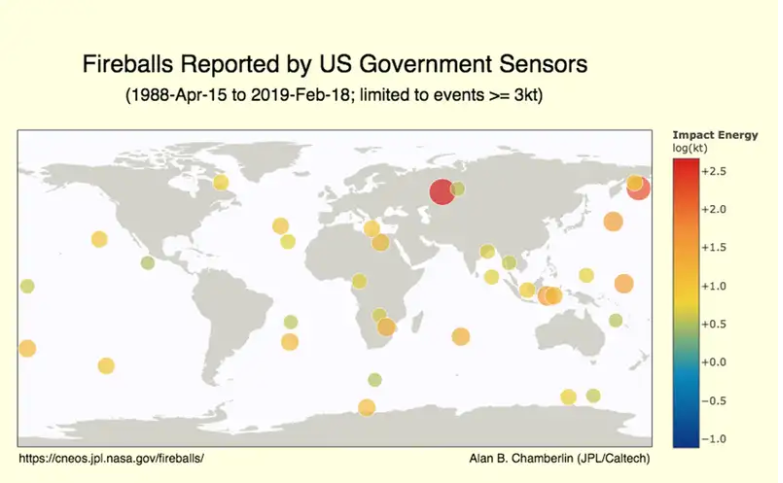A Huge Meteor Exploded Over Earth In December And We Didn't Even Notice
On December 18, a massive meteor exploded over in the earth’s atmosphere, but the details of the blast have just been uncovered recently. The fireball reportedly flew over the Bering Sea, in the Pacific Ocean between Russia and Alaska.
Researchers all over the world survey for signs of disturbance around the clock and many of them initially recorded the blast.
Peter Brown at the University of Western Ontario, Canada, spotted the meteor in measurements picked up by at least 16 monitoring stations globally, according to NewScientist.
Alan Fitzsimmons of Queen’s University Belfast, UK said that “It would have been quite spectacular,” to see.
The meteor was reportedly 10 meters in diameter and had a mass of 1400 tonnes. The meteor impacted with an energy of 173 kilotons of TNT, Peter Brown said on Twitter. The energy caused by the explosion was incredible, registering at nearly ten the force of the blast from an atomic bomb.
More Dec 18 airburst data from https://t.co/R81dQfvWpZ : object was 10m diameter, mass 1400T and impacted with an energy of 173 kT TNT, roughly 1/3 #Chelyabinsk. Impacts with this energy occur somewhere on Earth every few decades on average. #BeringSeaAirburst @westernu @IMOHQ
— Peter Brown (@pgbrown) March 8, 2019
Believe it or not, this type of occurrence is actually fairly common. Blasts like this have been recorded all over the world for the past few decades. The chart below shows fireballs spotted larger than three kilotons in the past several years.
“When you see these infrasound waves, you know immediately that there has been an impact or a large release of energy,” says Fitzsimmons.

This was the third-largest impact in modern history, surpassed by the 2013 Chelyabinsk explosion, and a huge blast in 1908 near Siberia, Russia. In the Chelyabinsk explosion, more than 900 hundred people were injured, mostly by broken glass. The meteor reportedly weighed 10 tons and entered the atmosphere at a speed of at least 54,000 kilometers per hour, exploding between 30 to 50 kilometers above the ground, According to NewScientist.
There are a large number of videos of the Russian meteor strike because it is common for Russian drivers to use dashboard-mounted cameras to prove liability in car accidents. This video footage gave scientists an unprecedented treasure trove of data for their research.
Of course, we have far less documentation of the Tunguska event, which occurred near Siberia in 1908 and flattened an estimated 80 million trees over an area of more than 2000 square kilometers. The Tunguska event is the largest impact event on Earth in recorded history. The explosion registered at seismic stations across Eurasia and air waves from the blast were detected in Germany, Denmark, Croatia, the UK, and as far away as Jakarta and Washington, D.C.
Chris Mattmann at NASA’s Jet Propulsion Laboratory says that the planet earth is regularly getting pelted with meteoroids.
“If you go out on a clear night, you’ll see little meteoroids burning up in the atmosphere,” he says.
However, since the vast majority of the earth’s surface is covered by water, many of these showers are never spotted by human eyes.
“It implies that there may be more small asteroids than we’re actually seeing in those telescopes,” says Fitzsimmons.
“We really should try to track more bodies to smaller sizes so that we have a better understanding of the threat from these kinds of air blasts,” Johnson added.
It is strange to think that asteroids are constantly passing through the earth’s atmosphere, sometimes getting burned up before they hit the ground, and other times causing massive explosions that are noticed and recorded by researchers but unknown by the rest of the world. Luckily, these blasts do not typically hit areas of high population density, so there has not been an extreme amount of damage or injuries.
Another thing that people don’t think about often is solar flares, which are also fairly common, and also vary in size, from undetectable to catastrophic, just as meteorites are. The most extreme solar flare in recorded history was the Carrington Event of 1859. Auroras were seen around the world, and telegraph and electrical systems around the were failing. However, the technology of the day was on such a small scale and was such a small part of life that it caused only minor disruptions in everyday life.
A solar storm of this magnitude occurring today would cause widespread electrical disruptions, blackouts, and damage due to extended outages of the electrical grid. The solar storm of 2012 was of similar magnitude, but it passed Earth’s orbit without striking the planet, missing by nine days, according to Wikipedia.
Featured image credit: Pixabay